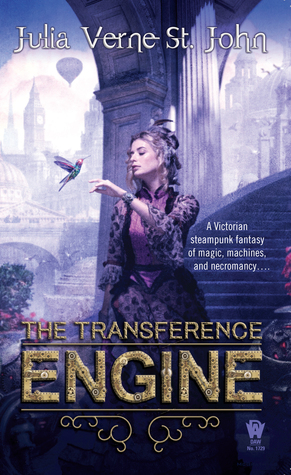 The Transference Engine by Julia Verne St. John
The Transference Engine by Julia Verne St. John Published by DAW on July 5th 2016
Genres: Fantasy, Steampunk
Pages: 320
Format: ARC
Source: Publisher





Julia Verne St. John’s fantasy steampunk alternate history novel The Transference Engine became one of my most anticipated releases of 2016 when The BiblioSanctum hosted the cover reveal for it earlier this year. The first time I glimpsed that beautiful cover was also the first time I’d heard of this book, and both the protagonist and the world sounded fascinating to me. A mystery involving necromancy, set in an alternate 1830s London that’s run on magic and machines? No way I wasn’t going to love this. In spite of my excitement though, by the time I was through the first few chapters, I realized I was probably going to have to adjust my expectations.
These first few dozen pages or so introduced us to Madame Magdala, the proprietress of the Book View Café, a magical library where patrons can sit and read while enjoying a cup of coffee and freshly baked pastries. However, the café’s centerpiece is a magical book sorting contraption designed by Ada Lovelace and Charles Babbage, a literal search engine that can find any book you ask for in the library’s collection. Magdala and Lovelace—the woman who will one day become the world’s first computer programmer—go way back, from the time Magdala was first hired by Ada’s mother to be a governess and protector for her daughter.
That’s because Ada’s father is also the notorious Lord Byron, the famous poet and depraved necromancer. Even after his death, Lady Byron feared that her husband’s followers would try to resurrect him in a new body using a soul-transferal machine called the Transference Engine. While the original machine was destroyed ten years ago, there’s no telling how far the necromancers will go to complete their task. Now, with reports of young men and women disappearing all around London (and several of the missing being employees of the Book View Café), Magdala is concerned that someone might be attempting to repair the Transference Engine by collecting enough innocent souls to bring back the one of Lord Byron.
In truth, I actually liked this novel. If I was a little disappointed, it’s only insofar because I thought I was going to love it. My main issue with the book was how slowly it started. For a 300-page novel, I typically expect things to be moving long by page 50, but this story didn’t pick up in earnest until more than halfway through, which is quite a lot to ask of your readers. I was feeling much more generous with The Transference Engine and kept reading because I genuinely was taken in by the world, but I think others might not be so patient. Not that the plot didn’t interest me, but I would have liked this a lot more if the major developments were presented sooner.
The number of confusing flashbacks was also another factor that played into the pacing issue. Part of the problem is that this book almost reads like a sequel, with the heroine constantly referring to events in the past like I should be aware of them already. This feeling of “sequel-ness” was so strong, I did some research after finishing The Transference Engine to see what I could find. It turned out, I was right—sort of. The character of Madame Magdala was actually first introduced in a collection of short stories called Steampunk Voyages, published by the author in 2013 under her name Irene Radford. Many of the past adventures Magdala mentions in The Transference Engine are apparently from this anthology, including her experiences involving her past clients, Mary Godwin and Percy Shelley (the latter was a necromancer too). Knowing all this, I understood the reason I felt so lost and confused was because I was effectively starting this story from behind.
That said, I really liked some of the characters and world-building elements. I actually wish these aspects could have been developed more, but the truth is this book was probably too short to fit all the ideas the author wanted. The narrative also spends way too much time on things I didn’t find as interesting, such as Magdala’s constant congratulating of herself for taking in orphans and other street children (almost like she has to remind us all every few minutes what a kind, magnanimous soul she is). In actuality, what I really wanted to know was more about the amazing technology in this world, like her little tiny clockwork hummingbird, or her awesome book finding machine. I’d also hoped that Ada Lovelace would feature more prominently in this book; I think she’s an incredible historical figure and it was such a shame that she didn’t play a bigger role in the story.
Once this book got going though, it really moved. All the set up in the first half of the novel paid off in the second, and I breezed through the story’s climax and conclusion. I don’t know if I can wholeheartedly recommend this since the beginning was so confusing and somewhat dull, but at least the ending was satisfying, even if it did wrap up a little too quickly and neatly. The pacing issues really hurt this novel, robbing this mystery story of its full potential, but there’s also plenty to like here if you’re a fan of the steampunk genre and enjoy reading about cool world-building ideas. If there’s a sequel, I can see pacing improving since the foundation has already been established, and I would be very curious to continue the story.
- Review: The Poppy War by R.F. Kuang - May 7, 2018
- Review: Glimpse by Jonathan Maberry - April 23, 2018
- Review: One Way by S.J. Morden - April 9, 2018


No Comments
Comments are closed.